PORSCHE CAYNNE S 2006 1.G Service Manual
Manufacturer: PORSCHE, Model Year: 2006, Model line: CAYENNE S, Model: PORSCHE CAYENNE S 2006 1.GPages: 420, PDF Size: 3.81 MB
Page 41 of 420
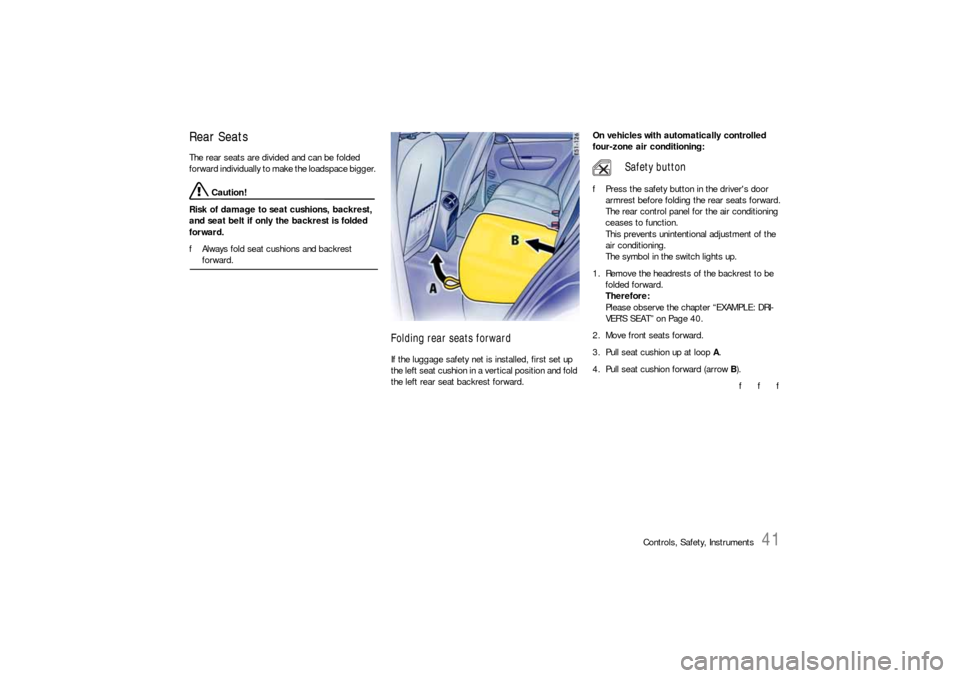
Controls, Safety, Instruments
41
Rear SeatsThe rear seats are divided and can be folded
forward individually to make the loadspace bigger.
Caution!
Risk of damage to seat cushions, backrest,
and seat belt if only the backrest is folded
forward.
fAlways fold seat cushions and backrest forward.
Folding rear seats forwardIf the luggage safety net is installed, first set up
the left seat cushion in a vertical position and fold
the left rear seat backrest forward.On vehicles with automatically controlled
four-zone air conditioning:
fPress the safety button in the driver's door
armrest before folding the rear seats forward.
The rear control panel for the air conditioning
ceases to function.
This prevents unintentional adjustment of the
air conditioning.
The symbol in the switch lights up.
1. Remove the headrests of the backrest to be
folded forward.
Therefore:
Please observe the chapter “EXAMPLE: DRI-
VER’S SEAT” on Page 40.
2. Move front seats forward.
3. Pull seat cushion up at loop A.
4. Pull seat cushion forward (arrow B).
f f f
Safety button
Page 42 of 420
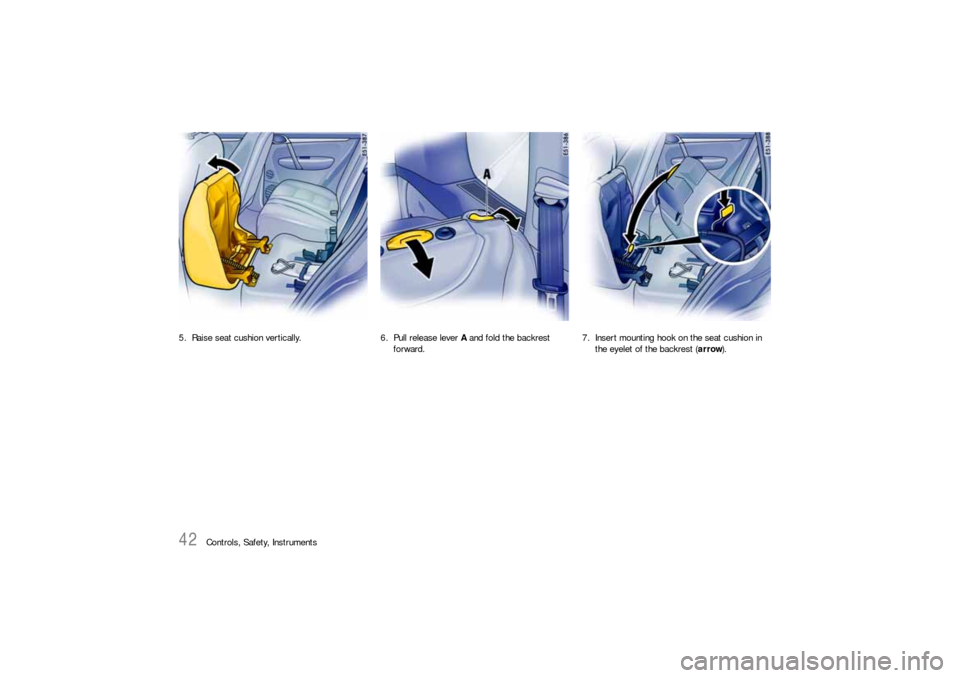
42
Controls, Safety, Instruments 5. Raise seat cushion vertically. 6. Pull release lever A and fold the backrest
forward. 7. Insert mounting hook on the seat cushion in
the eyelet of the backrest (arrow).
Page 43 of 420
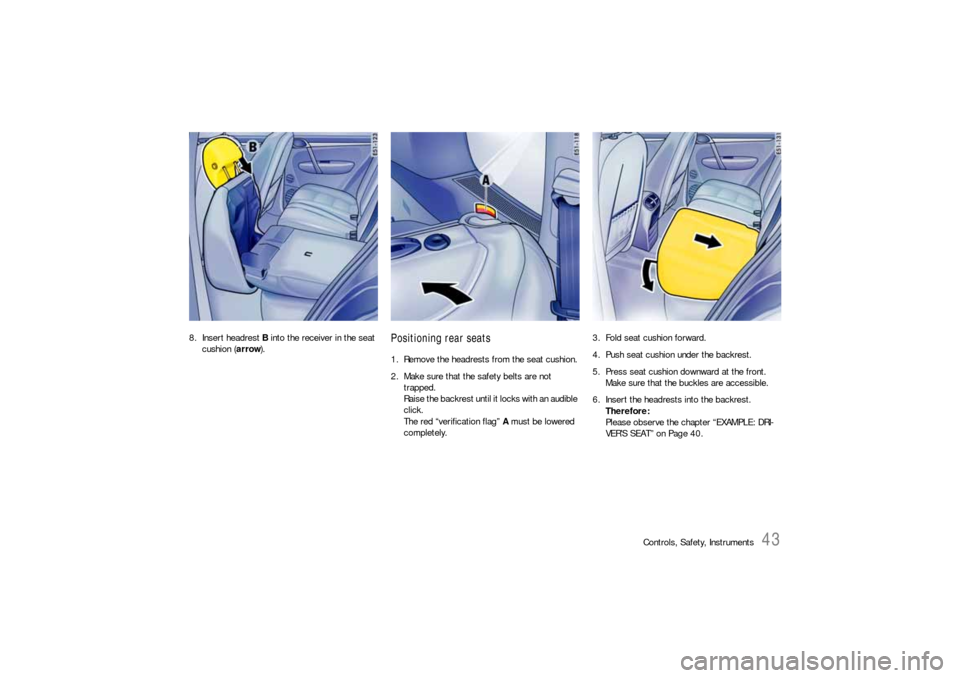
Controls, Safety, Instruments
43
8. Insert headrest B into the receiver in the seat
cushion (arrow).
Positioning rear seats1. Remove the headrests from the seat cushion.
2. Make sure that the safety belts are not
trapped.
Raise the backrest until it locks with an audible
click.
The red “verification flag” A must be lowered
completely.3. Fold seat cushion forward.
4. Push seat cushion under the backrest.
5. Press seat cushion downward at the front.
Make sure that the buckles are accessible.
6. Insert the headrests into the backrest.
Therefore:
Please observe the chapter “EXAMPLE: DRI-
VER’S SEAT” on Page 40.
Page 44 of 420
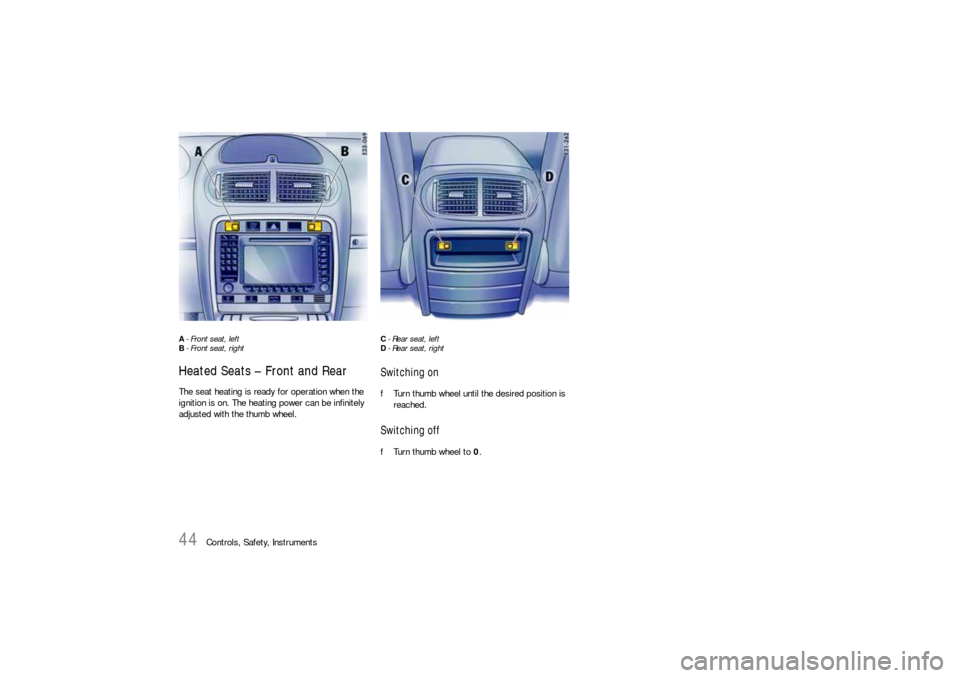
44
Controls, Safety, Instruments
A- Front seat, left
B- Front seat, rightHeated Seats – Front and RearThe seat heating is ready for operation when the
ignition is on. The heating power can be infinitely
adjusted with the thumb wheel.
C-Rear seat, left
D- Rear seat, rightSwitching onfTurn thumb wheel until the desired position is
reached.Switching offfTurn thumb wheel to 0.
Page 45 of 420
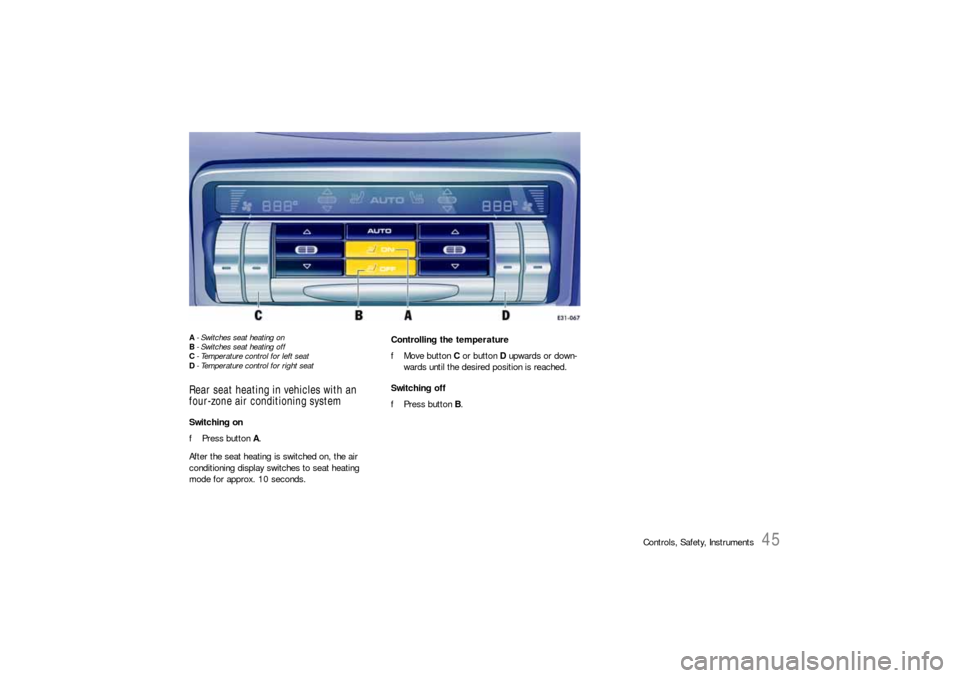
Controls, Safety, Instruments
45
A- Switches seat heating on
B- Switches seat heating off
C- Temperature control for left seat
D- Temperature control for right seatRear seat heating in vehicles with an
four-zone air conditioning systemSwitching on
fPress button A.
After the seat heating is switched on, the air
conditioning display switches to seat heating
mode for approx. 10 seconds.Controlling the temperature
fMove button C or button D upwards or down-
wards until the desired position is reached.
Switching off
fPress button B.
Page 46 of 420

46
Controls, Safety, Instruments
Safety Belts
Danger!
Always make sure your and your passengers'
safety belts are properly fastened while the
vehicle is in motion.
Failure to follow safety belt warnings may re-
sult in serious personal injury or death.
fFor your and your passengers' protection, use
safety belts at all times while the vehicle is in
motion.
fUse appropriate child restraint systems for all
small children.
Proper wearing of safety belts
fS a f e t y b e l t s m u s t b e p o s i t i o n e d o n t h e b o d y a s
to restrain the upper body and lap from sliding
forward. Improperly positioned safety belts
can cause serious personal injury in case of an
accident.
fThe shoulder belt should always rest on your
upper body. The shoulder belt should never be
worn behind your back or under your arm.
fFor maximum effectiveness, the lap belt
should be worn low across the hips.
fPregnant women should position the belt as
low as possible across the pelvis. Make sure it
is not pressing against the abdomen.
fBelts should not be worn twisted.fDo not wear belts over rigid or breakable ob-
jects in or on your clothing, such as eye glass-
es, pens, keys, etc. as these may cause injury.
fSeveral layers of heavy clothing may interfere
with proper positioning of belts.
fBelts must not rub against sharp objects or
damage may occur to the belt.
fTwo occupants should never share the same
belt at the same time.
Care and maintenance
fKeep belt buckles free of any obstruction that
may prevent a secure locking.
fBelts that have been subjected to excessive
stretch forces in an accident must be inspect-
ed or replaced to ensure their continued effec-
tiveness in restraining you.
The same applies to belt tensioner systems
which have been triggered. In addition, the an-
chor points of the belts should be checked.
fIf safety belts do not work properly, see your
authorized Porsche dealer immediately.
fI f t h e b e l t s s h o w d a m a g e t o w e b b i n g , b i n d i n g s ,
buckles or retractors, they should be replaced
to ensure safe operation.
fDo not modify or disassemble the safety belts
in your vehicle.fThe belts must be kept clean or the retractors
may not work properly.
Please observe the chapter “CAR CARE IN-
STRUCTIONS” on Page 284.
fNever bleach or dye safety belts.
fDo not allow safety belts to retract until they
are completely dry after cleaning or this may
cause damage to the belt.
Page 47 of 420
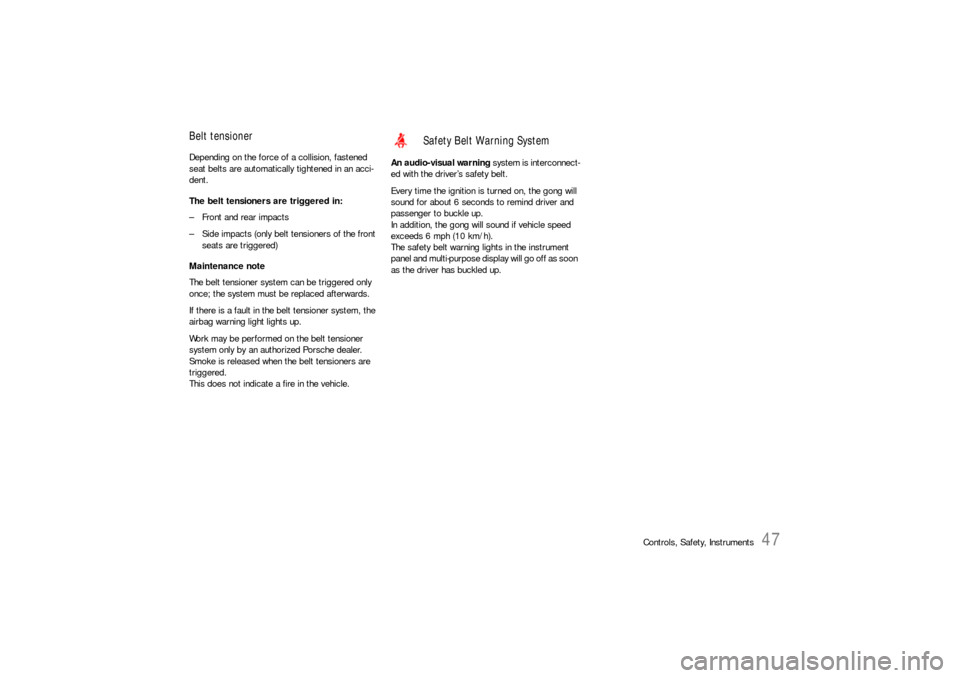
Controls, Safety, Instruments
47
Belt tensionerDepending on the force of a collision, fastened
seat belts are automatically tightened in an acci-
dent.
The belt tensioners are triggered in:
– Front and rear impacts
– Side impacts (only belt tensioners of the front
seats are triggered)
Maintenance note
The belt tensioner system can be triggered only
once; the system must be replaced afterwards.
If there is a fault in the belt tensioner system, the
airbag warning light lights up.
Work may be performed on the belt tensioner
system only by an authorized Porsche dealer.
Smoke is released when the belt tensioners are
triggered.
This does not indicate a fire in the vehicle.An audio-visual warning system is interconnect-
ed with the driver’s safety belt.
Every time the ignition is turned on, the gong will
sound for about 6 seconds to remind driver and
passenger to buckle up.
In addition, the gong will sound if vehicle speed
exceeds 6 mph (10 km/h).
The safety belt warning lights in the instrument
panel and multi-purpose display will go off as soon
as the driver has buckled up.
Safety Belt Warning System
Page 48 of 420
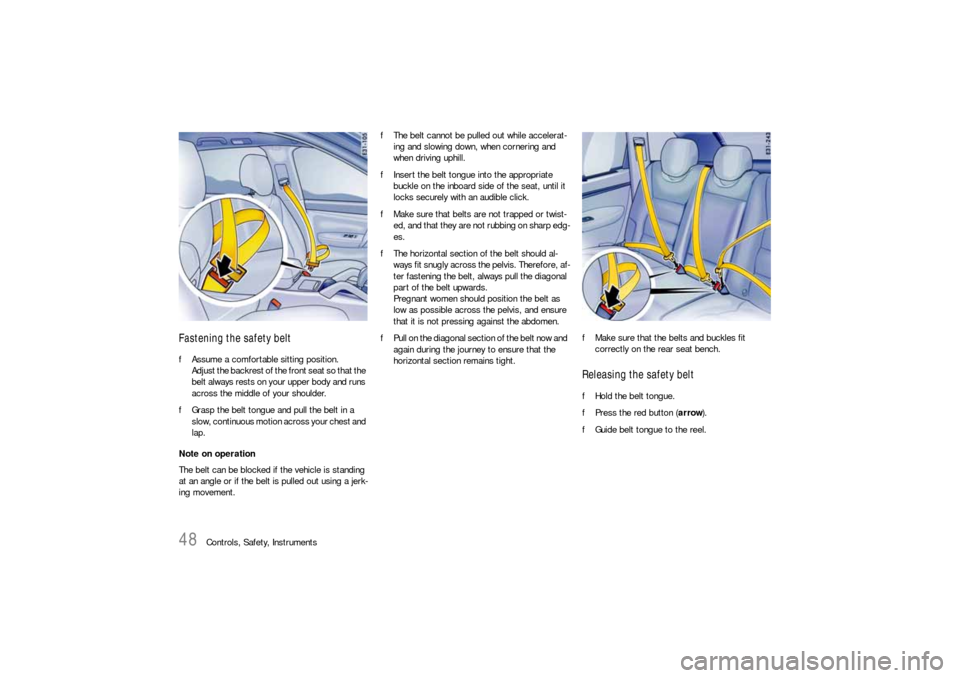
48
Controls, Safety, Instruments
Fastening the safety beltfAssume a comfortable sitting position.
Adjust the backrest of the front seat so that the
belt always rests on your upper body and runs
across the middle of your shoulder.
fGrasp the belt tongue and pull the belt in a
slow, continuous motion across your chest and
lap.
Note on operation
The belt can be blocked if the vehicle is standing
at an angle or if the belt is pulled out using a jerk-
ing movement.fThe belt cannot be pulled out while accelerat-
ing and slowing down, when cornering and
when driving uphill.
fInsert the belt tongue into the appropriate
buckle on the inboard side of the seat, until it
locks securely with an audible click.
fMake sure that belts are not trapped or twist-
ed, and that they are not rubbing on sharp edg-
es.
fThe horizontal section of the belt should al-
ways fit snugly across the pelvis. Therefore, af-
ter fastening the belt, always pull the diagonal
part of the belt upwards.
Pregnant women should position the belt as
low as possible across the pelvis, and ensure
that it is not pressing against the abdomen.
fPull on the diagonal section of the belt now and
again during the journey to ensure that the
horizontal section remains tight.fMake sure that the belts and buckles fit
correctly on the rear seat bench.
Releasing the safety beltfHold the belt tongue.
fPress the red button (arrow).
fGuide belt tongue to the reel.
Page 49 of 420
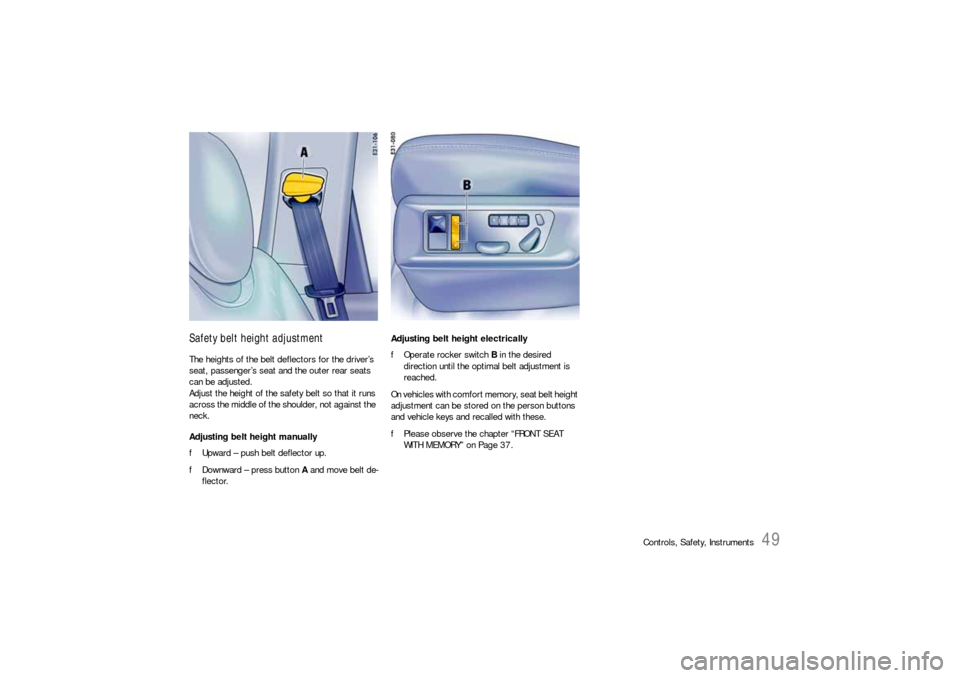
Controls, Safety, Instruments
49
Safety belt height adjustmentThe heights of the belt deflectors for the driver’s
seat, passenger’s seat and the outer rear seats
can be adjusted.
Adjust the height of the safety belt so that it runs
across the middle of the shoulder, not against the
neck.
Adjusting belt height manually
fUpward – push belt deflector up.
fDownward – press button A and move belt de-
flector.Adjusting belt height electrically
fOperate rocker switch B in the desired
direction until the optimal belt adjustment is
reached.
On vehicles with comfort memory, seat belt height
adjustment can be stored on the person buttons
and vehicle keys and recalled with these.
fPlease observe the chapter “FRONT SEAT
WITH MEMORY” on Page 37.
Page 50 of 420

50
Controls, Safety, Instruments
Airbag SystemsThe airbags in combination with the safety belts
make up a safety system which offers the driver
and the passenger the greatest known protection
from injuries in case of accident.
Your vehicle is equipped with weight sensing for
the passenger's seat in accordance with U.S. Fed-
eral/Canadian Motor Vehicle Safety Standard
208.
Even if your vehicle is equipped with airbags, the
safety belts must be worn at all times,
because the front airbag system is only actuated
by frontal collisions with an impact of sufficient se-
verity.
Seatbelts always provide the primary protection to
occupants in the event of collision, when correctly
worn. This is particularly the case in collisions be-
low airbag actuation thresholds.
Therefore, all persons within the vehicle
must wear safety belts at all times (in many
states, state law requires the use of safety belts).
fPlease observe the chapter “SAFETY BELTS”
on Page 46.
The front airbags are located under the padded
steering wheel panel on the driver’s side and, on
the passenger's side, in the dashboard.
The side airbags for the front seats are installed
on the side in the seat backrests.
The head airbags are installed above the doors
in the roof area.